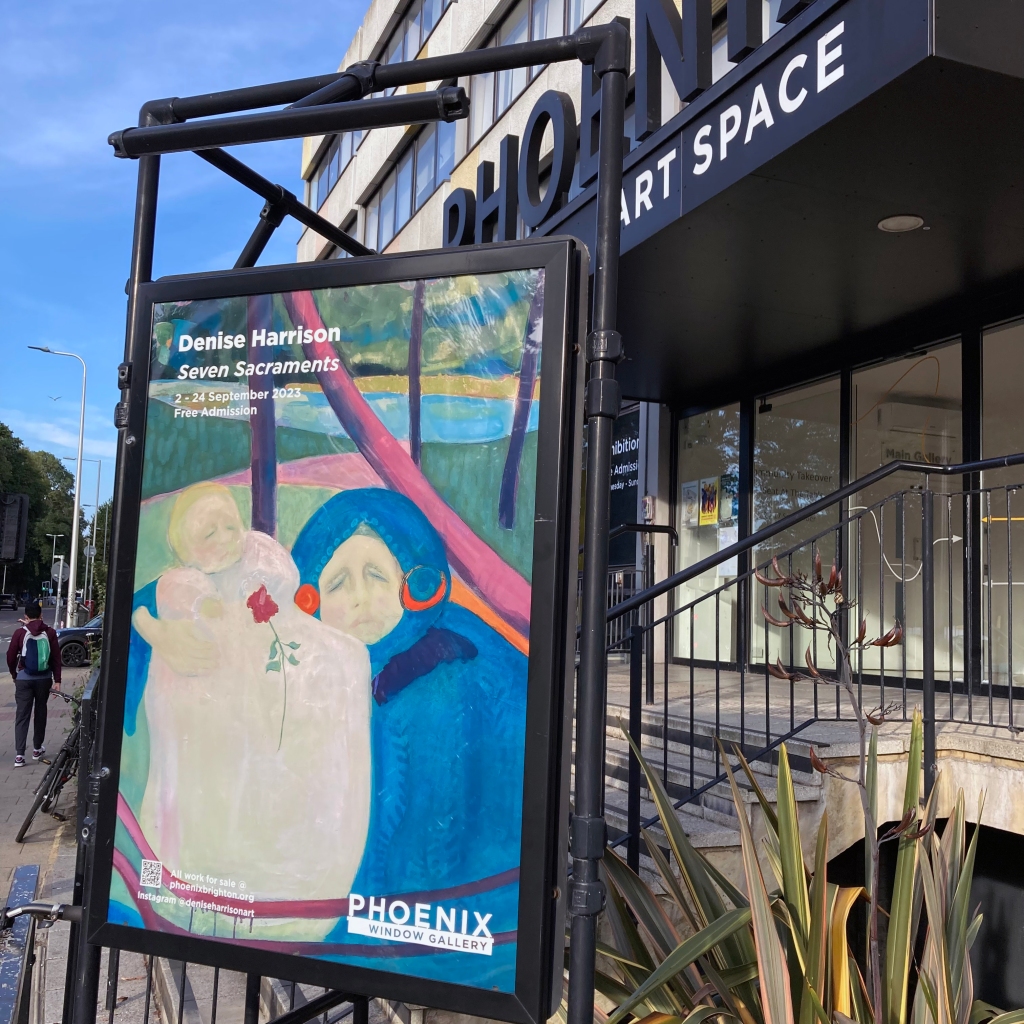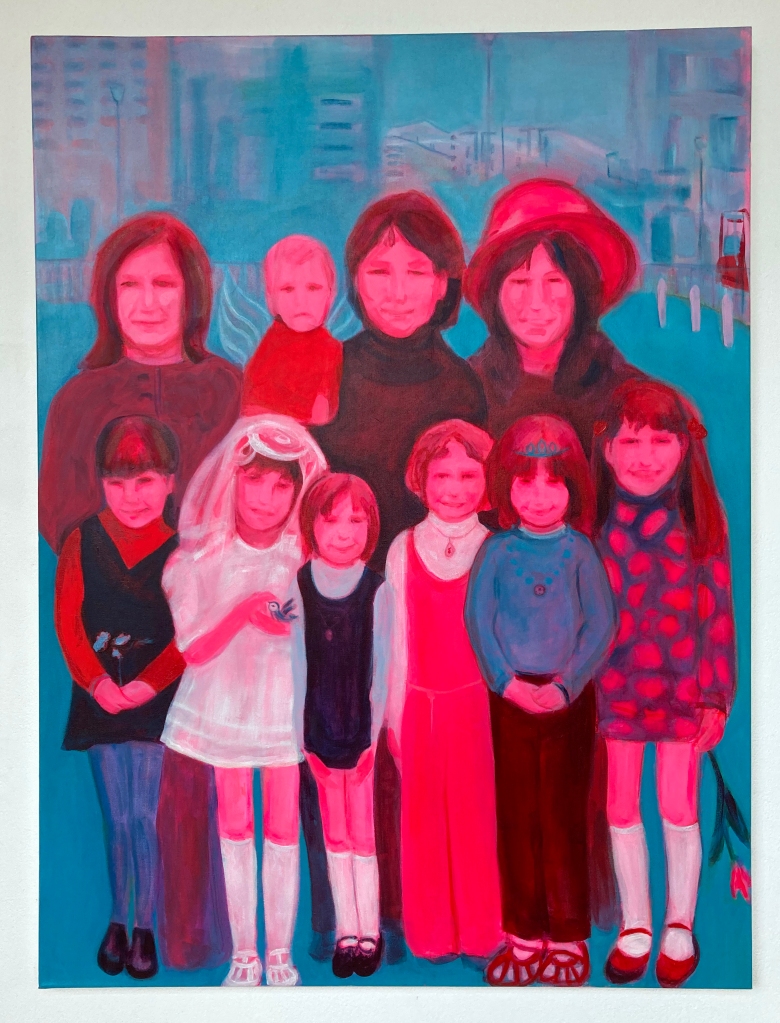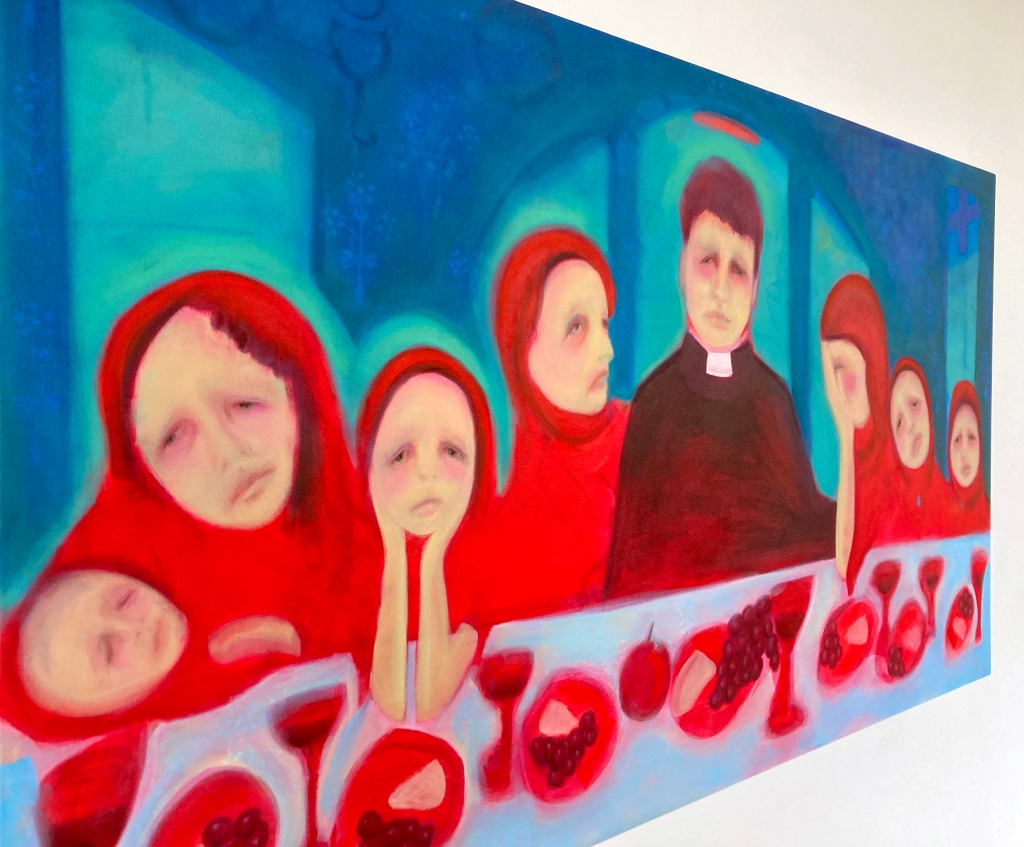Window Gallery, Phoenix Art Space, Brighton
2 to 24 September 2023
“Denise’s current body of work explores memory, loss and place using the rituals of the Seven Sacraments that marked the milestones of her family’s life-events and gatherings. These memories are then re-imagined with the additional knowledge that is acquired. This work is about exploring the loss of her mother to head and neck cancer. Each of the seven sacraments has a narrative, a memory. When exploring old photos and family memories, her relationship to these images change according to life experience, what was once a fleeting memory suddenly becomes a treasured and precious embrace that can now only be experienced in her thoughts and on her canvas.” (Phoenix Art Space website)
Why visit a painting exhibition? For pleasure, to be inspired, to engage in a sort of communion, to be challenged even? This is human behaviour best explained by an anthropologist, no doubt. I suspect we have performed this ritual in different ways and contexts for a wide variety of reasons, in many forms, since the era of the cave painting. Closer to home, and today, the introduction from the Phoenix web site (above) succinctly sets the visitor up for something more than a superficial aesthetic experience for Denise Harrison’s thought provoking exhibition, The Seven Sacraments.
I was able to initially see the seven paintings and two small mixed media works in advance of the official opening and before those last, final tweaks with wall labels and the switching on of a video player. This was usefully raw as the final polishing for display was still a day or two away. I had previously seen some of these works in progress in Harrison’s Phoenix studio over the past few months. But here they were, finally resolved and ready for viewing as a group rather than as singular items in various phases of completion. Perhaps the studio is the notional cave from which the work emerges, requiring a suitably lit and formal viewing context. There is no more disappearing into the depths of the earth to celebrate or ritualise through what we now call ‘art’. This is a truly powerful set of oil and acrylic paintings that carefully balance colour impact with emotional content. This is certainly not mere (contemporary) wall decoration made for interior design purposes; it’s a visual witness statement conjuring the moving, melancholic and sometimes distressing subject matter of religious expectations and obligations for the family – yet I believe reveals a thoughtful and affectionate reflection on the presence of love within a family across generations.
My first impressions were divided between a reading of the powerful narrative in the series of paintings, including a reconsideration of the notion of time, and the visual impact of the colour combinations and paint handling that pulled in the eye as well as the mind. The memorial content, based on individuals and familial groupings – from ten parents and children in ‘First Communion’, pairings in ‘Baptism’ and ‘Wedding’, to a rather sad looking ‘St Bernadette’ displayed in the annex of the café – connected the works as forms of portraiture and stage settings. There are Shakespearian echoes here as we may well eventually realise that, “All the world’s a stage, And all the men and women merely players…” But the players here of course are set in a religious, Catholic context. As an outsider to this faith I cannot really comment knowingly on the lived experience of adhering to the Seven Sacraments or of being directly involved in what appears to be a range of disturbing experiences for one particular family. The priest in ‘Ordination: Fr. Shannon’, the centrepiece of the display, doesn’t seem to represent any spiritual joy for himself or for his flock of seven red-clad females. As a counterpoint to any notion of spiritual exultation another emotionally moving image is ‘Last Rites: Despair’ where the ailing mother/grandmother appears alone despite the presence of three younger but ghostly figures in the foreground. The content sounds harrowing, but its production ultimately feels strangely rapturous. This reading is, admittedly, personal and intuitive on my part, but I think it has something to do with the painting and this sense of love that I mentioned above.
In a more general sense there is a sense of time as well. Of duration rather than moments, despite the imagery being derived from family snap shots, and the artist’s memory. This time aspect might be more strongly felt by the older viewer, although the younger visitor will ‘get it’ intellectually. The implied presence of the camera is here too as the imagery is akin to looking at a photograph, or a photo-album. There could be a desire to know who, where, when and why but art works on universal levels as well as with local, specific histories. Although it’s not the case here, one might have found the original photographic prints (not on display) in a house clearance but the treatment and editing of the information is clearly specific to the artist’s own history. A story now shared to expand from the individual and the familial to the communal. Paintings cannot escape this fate once they become public and face scrutiny.
Still ruminating on this sense of time it struck me that as we age, time and memories collapse in a sense. Some degree of linearity remains but as we can all look back at our own histories through time we also belong to a family, like or unlike the one recorded here. This may not necessarily be nostalgic in a truly celebratory sense – this sounds too rosy spectacled. But the filters are removed decades on, or perhaps replaced by something at least a little clearer. You have to be outside and beyond to look in, sometimes feeling like a stranger or third party. But you’re still in there, somehow, and this forms identity broadened beyond oneself. Paintings can present contradictions that we can allow ourselves to go with. Paintings are poems, not screen plays.
With regard to painting the viewer might be struck initially by Harrison’s use of glowing pinky reds and airy blues in addition to the strong figurative content representing facial features, especially the eyes and the expressions of the mouth. The various colour shapes morph with their surroundings producing a dream-like, visual connectedness that forces, or frees up, the figurative confines of the photographic content to flow and expand by use of the paint medium. With its various aspects of selection, composition, colour choice, painterly application and materiality the paintings somehow challenge the original photographs to attempt to say more than a superficial reading might offer. A painting, a good one, might read more like a poem that does not explain all. A straightforward story will need some openness for the viewer’s own interpretation and meaning to arise. Narrative is potentially unsteady, open to interpretation and unavoidably filtered and synthesised by the onlooker. Meanings might change from one gaze to the next. Or at the very least we might adapt the various scenarios to our own histories and experiences as a way of dealing with trauma that is beyond the individual, residing in the family and across generations. I am aware that I am probably getting carried away here, beyond the intentions of the artist, but a visitor could not walk through this space without exchanging a ‘look’ with the various individuals depicted and possibly find an echo in there.
An affirmation of painting is also powerfully and skilfully evoked by a suggestion of the purposely unsophisticated veering on apparent clumsiness. For example a limb such as a leg that is too straight, or a head too big or childishly bulbous. This somewhat unfair attribution emerges as there is clearly something of the lens-based / photographic record in the visual language that sparks an expectation for some category of the photo-realistic. But this combination somehow works. The apparent distortions and simplifications are deliberate. The colour is sometimes acidic and contrasts are crudely intentional. Detail, for example, is reserved for eyes and mouths, whereas bodies and surrounding forms and spaces tend towards a more abstract language as backdrops from the theatre of the everyday to make the imagery emotionally real. These people are us, vulnerable and loving, lost and found.
Visit this exhibit if you can. Support for artists is about engagement with their works and ideas. Be baffled and be sure. Participate and trust. We need to share our stories and painting does this so well.
Geoff Hands
Links:
Instagram:
@deniseharrisonart
@phoenix_artspace
Shakespeare: “All the world’s a stage” speech from ‘As You Like It’ by William Shakespeare, spoken by Jaques. https://www.poetryfoundation.org/poems/56966/speech-all-the-worlds-a-stage





